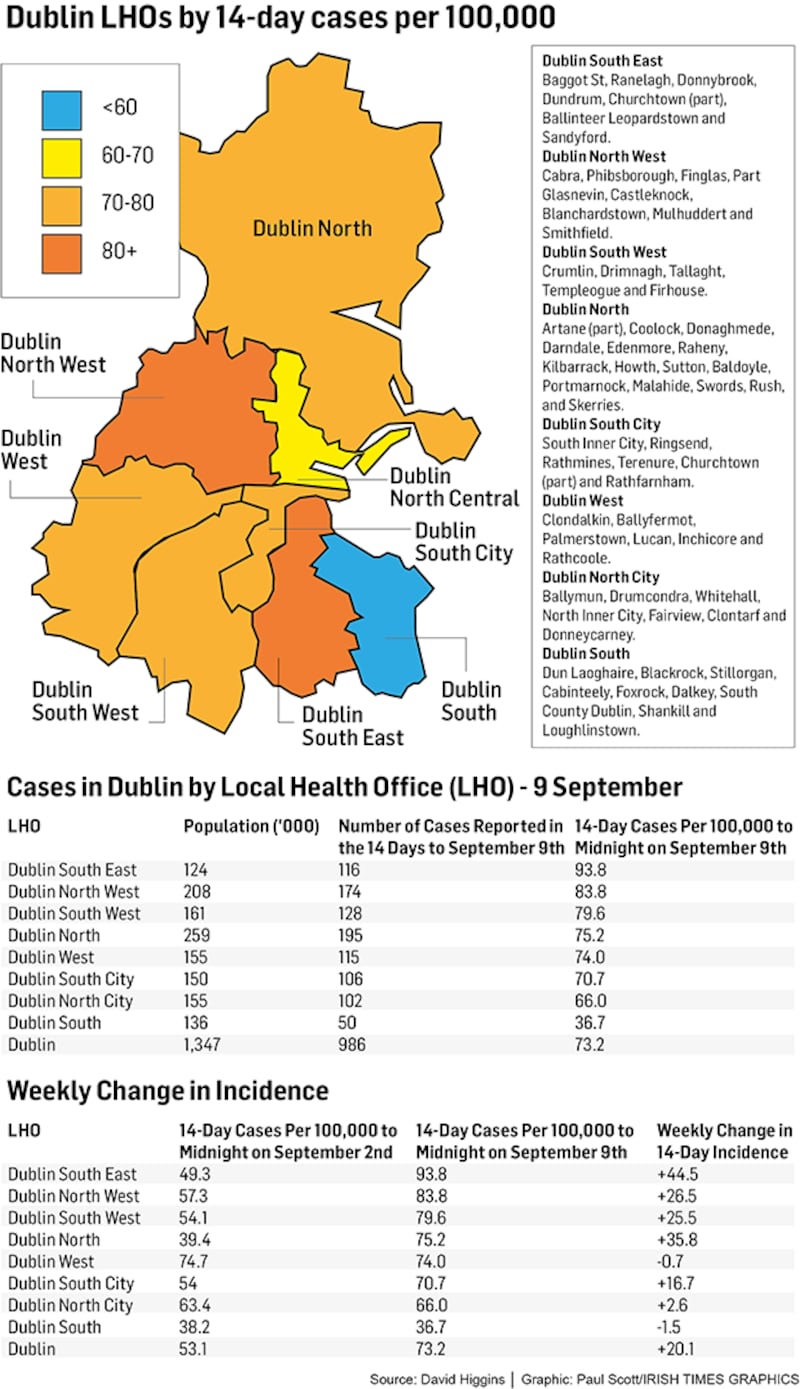Parts of Dublin have Covid-19 infection rates 2½ times as high as neighbouring areas in the capital, according to the latest figures from the Health Protection Surveillance Centre (HPSC).
For example, the number of cases appearing in Dublin South East – including parts of the south city centre and Dundrum and Ballinteer – are 155 per cent higher than those being found in Dublin South.
The figures cover cases as recorded by the HSE local health office (LHOs) areas, which have been collated by David Higgins, an economist with Carraighill data analysts.
Dublin South East, which stretches from Baggot Street through Rathmines and Ranelagh to Leopardstown and Sandyford, recorded 93.8 Covid-19 case per 100,000 people in the 14 days between August 27th and September 9th.
Meanwhile, Dublin South, which comprises of Dún Laoghaire, Stillorgan, Foxrock and down to Loughlinstown, recorded just 36.7 cases of Covid-19 per 100,000 in the same period.
Dublin North West, which stretches from Cabra to Mulhuddart and includes many recently-built areas in west Dublin, is another hot spot for the disease, with an instance of 83.8 cases of Covid-19 per 100,000.
Across the capital an average of 73.2 Covid-19 cases per 100,000 people is now being recorded, which is a significant increase on cases collated between August 20th and September 2nd, and August 27th and September 9th.
The worst affected area, Dublin South East, had 44.5 more weekly cases in the week between September 2nd and 9th as it did between August 20th and August 27th. Dublin North, by contrast, had 35.8 extra cases between that time.
Ranelagh-based GP Dr Maitiu Ó Tuathail said the differences between Dublin South and Dublin South East is explained by demographics. Those who live in Dublin South are older and more settled, he suggests.
“We have a large population of young people who work in tech and attend college. We have seen increases in demand for tests weeks ago, and it has just steadily been increasing since lockdown measures were reversed.
“The Ranelagh, Rathmines, Grand Canal area has a very sociable demographic. It fits the current trend in statistics that we are seeing with the majority being under 45,” he said.
Higher poverty
Dr Ray Walley, a GP based in Glasnevin, which is part of the Dublin West area, said the high numbers currently in his area may be explained by higher poverty and more people living together.
Black, Asian and middle-eastern communities have already been shown in the UK to be more vulnerable to Covid-19, and the same may be occurring in north and west Dublin, both of which have higher immigrant numbers.
“They are a more vulnerable group and they are looking into why that it is – it may be vitamin D deficiency,” he said.

Epidemiologist Prof Sam McConkey said the wide differences being seen in Dublin shows that a general lockdown of the city would not be justified. The public should be told more about Covid-19 cases in their neighbourhoods .
“Dublin is 1.5 million people. It is too big to be treated as one area,” said Prof McConkey, “This is a geographically heterogeneous disease, and there should be a heterogeneous response to it.
“There are huge differences in different areas. We need strict restrictions and awareness in the areas where there is a lot of transmission. In the areas with less transmission we need to be less panicky.”
The breakdown of Covid-19 case numbers over the last 14 days by local health office districts is the most detailed information given by the HPSC. It does release data by electoral districts, but only on a two-month basis.
Higgins said more granular detail from the HPSC would precisely identify hot spots. “It’s unlikely that every neighbourhood within Dublin South East is experiencing a strong outbreak. It could be quite localised.”
Speaking in Co Cork, Taoiseach Micheál Martin said “there is not going to be a knee-jerk reaction” to rising infection rates in Dublin as he played down suggestions of a regional lockdown in the capital.
Ahead of the publication on Tuesday of the Government's plan for tackling Covid-19 over the next six months, he said: “We have got to be clever, we have got to be smart and we have to be resilient in terms of how we deal with it. The overarching objective must be public health but equally to protect livelihoods and keep people working and then have a decent quality of life for our children and our people overall.”













